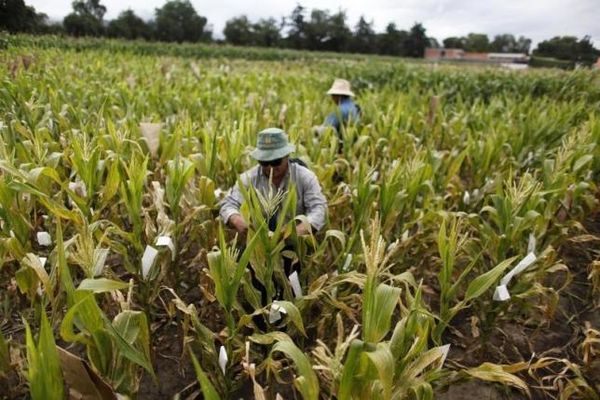As El Nino looms, cloud seeding gets tailwind
Date: 08-Jul-15
Country: AUSTRALIA
Author: Colin Packham

Scientists work in a field of maize plants at the International
Maize and Wheat Improvement Center (CIMMYT) in El Batan on the
outskirts of Mexico City August 31, 2010.
Photo: Eliana Aponte
Circling thousands of feet above Tasmania's farmland in a light aircraft, Christina Nebel prepares to release tiny chemical particles as part of a cloud-seeding scheme estimated to have helped boost rainfall on the Australian island by over 10 percent.
The program is one of a handful globally riding a wave of renewed interest in the decades-old technology as drought hits places from the United States to the Philippines, with the specter of a strong El Nino weather pattern later this year threatening worse to come.
"We are looking for fronts crossing Tasmania," said Nebel, cloud seeding officer at renewable energy producer Hydro Tasmania.
If the conditions are right, she releases a small amount of silver iodide, which attracts water particles, encouraging clouds to grow and, she hopes, rain on the land below.
But Tasmania is blessed with near-perfect conditions for the process with clouds containing a large amount of cold water vapor whipping in off the Southern Ocean, meaning the scale of success of its program, which has its roots in the 1960s, could be difficult to replicate elsewhere.
Nonetheless atmospheric experts say the technology is enjoying a renewed emphasis as governments fret over scorching weather and as populations grow, while falling costs could increase its use in future.
"What is driving the attention is that winter cloud seeding holds some promise and in many places, including the western U.S., water shortages are becoming severe," said Professor Terry Deshler from the University of Wyoming's atmospheric science department.
Research suggests cloud seeding in winter produces better results than in other periods.
RAIN AGAIN?
While many of the world's cloud-seeding programs are small and unlikely to have more than a limited impact, China has a large-scale scheme in place.
The nation launched its "human affected weather" program in 1958, and has done extensive research in cloud seeding. It aims to induce more than 60 billion cubic meters of additional rain each year by 2020 using the technique, as it looks to fight chronic water shortages.
That figure is equivalent to more than one-and-a-half times the volume of the Three Gorges reservoir, one of the largest in the country.
On a far smaller scale, the government in the Philippines, one of the world's biggest rice consumers, is spending a record 15 million pesos ($330,000) this year on cloud-seeding operations and could allocate another 15 million pesos in the face of El Nino, which can bring crop-damaging dry weather to many regions.
"We of course don't want to be caught unprepared, especially now that weather experts are predicting a prolonged El Nino," said Silvino Tejada, director of the Philippines Bureau of Soils and Water Management.
The cost of cloud seeding has traditionally been one of the main hurdles to usage. Fuel costs are often the biggest drag on budgets, researchers said, with some seeding operations often requiring multiple flights.
But the Nevada-based Desert Research Institute has recently started testing drones that could be used in cloud seeding that it says could cut costs substantially. Drones would also be able to fly closer to mountains, where clouds offer the best potential for seeding.
Back in Tasmania, Nebel is busy, with 10 seeding operations so far in the season that runs from May to October, more than double the number at the same point in 2014.
That water falls into irrigation channels and onto pasture and feed crops, helping boost the state's dairy sector, where milk production is up about a tenth so far this season.
(Additional reporting by Enrico Dela Cruz in Manila; Editing by Joseph Radford)
![]()
© Thomson Reuters 2015 All rights reserved